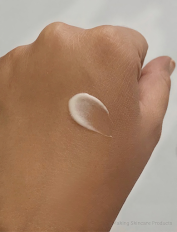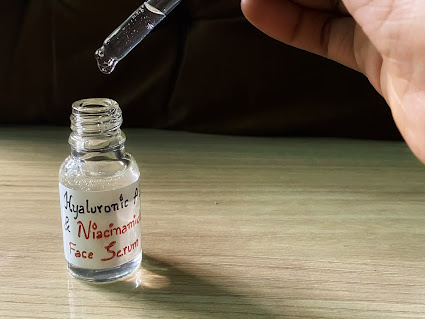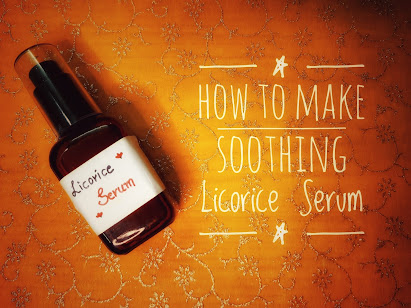DIY Vitamin C Day Cream
Creams 101 Part 3- Vitamin C Day Cream
In the right is the sample of Vitamin C cream. It has softer texture which is thick and creamy.
This cream is modified from Part 2 Hand cream. We have eliminated Beeswax and Shea Butter since it can make skin look oily in hot and humid environment.
Added an active ingredient MAP (Magnesium Ascorbyl Phosphate) which is a form of Vitamin C. Since this works best around pH 6, we have included preservative which works at that preservative.
This is in continuation of our series Creams 101. In Part 1, we have discussed about the ingredients
required to make a Basic Cream.
In Part 2, we have made a Natural Moisturizing Hand and Body
Cream. In Part 3, we are going to make a Vitamin C Day Cream. It is a modified version of Part 2.
Ingredients Required:
Phase B:
Glycerin 2%
Sodium gluconate 0.1%
Xanthan Gum 0.2%
Distilled Water 81.9%
MAP 1%
Betaine 1%
Allantoin 0.5%
Phase C:
Euxyl PE 9010 1%
Vitamin E Tocopherol 0.1%
Calendula extract 0.5%
Moon light F.O 0.7%
Green tea extract 1%
Moon light Fragrance oil is a gift from Earthy Drops. The smell is so mild and soothing. It suits for day and night creams, also hair care products.
If you would like to buy sample fragrances or complete range, here is the contact number: +91 77603 09934
Heated Oil Phase:
Rice bran is rich in antioxidants and has moisturizing properties. I use in my personal creams since
it is suitable for hot climate and is also easily available. Make sure to get the cosmetic grade one.
You could use Jojoba oil, Grapeseed oil or Sweet almond oil.
Emogreen L19 is a natural silicone replacement. It reduces greasy feel and increases the slip in
creams. It can be replaced with other natural silicones like Isoamyl laurate.
Olivem 1000 in combination with Cetyl alcohol makes fluffy and soft creams which have a great
sensory feel. It can be replaced with other natural emulsifiers like Montanov 68 or non natural ones
like Emulsifying wax NF, BTMS 50 or Lotion Pro. Any swap or replacement can have a change in
feel since different ingredients have different combinations.
Heated Water Phase:
Glycerin: Small amount of humectant to add some moisturizing properties. This can be increased or
replaced with other humectants like sodium lactate.
Sodium gluconate is a chelating ingredient to increase the stability and preservation. EDTA is replacement for Sodium Gluconate.
Xanthan Gum: This improves the feel, viscosity and stability of a cream. Little amount of gum can
bring a noticeable difference in feel and viscosity.
The form of Vitamin C used is Magnesium Ascorbyl Phosphate which is a stable form and water
soluble. I have used at 1% to add antioxidant properties. But you can use it up to 3%. The higher
doesn’t always mean the best, you can add percentage that you desire but stability testing is
suggested before you sell. It can be added to heated water phase or in cool down phase by mixing in
small amount of water.
In general Vitamin C creams have L Ascorbic acid but it is not stable and a tricky one to work with. Other forms of Vitamin C like 3,o ethyl ascorbic acid, sodium ascorbyl phosphate etc. can be used but the pH requirements and usage rate are different.
Betaine is another humectant which is vegan and doesn’t have tacky feel but adds moisturizing
properties. It is also soothing and calming.
Allantoin: Allantoin is anti-irritant which also soothes skin.
Soothing ingredients are added to prevent itching and irritation due to hot climate.
Cool down Phase:
Euxyl PE 9010: Phenoxyethanol and Ethylhexylglycerin: This is effective broad spectrum
preservative and is not irritating. I didn’t notice any irritation with this preservative, neither my
friends and family for whom I make creams. This doesn’t mean other ones are irritating. I am
suggesting the one that I have used and is suitable in hot climatic areas. The only drawback is it is
not natural one.
This cream should have a pH of 6 because MAP works best around 6. It can discolor if the pH is
low and may be irritating at a higher pH. Euxyl PE 9010 works at pH 6, so this preservative is used.
Other broad spectrum preservative like Liquid Germall Plus can also be used.
Vitamin E Tocopherol: It is an antioxidant which improves the stability of cream by preventing
rancidity.
Calendula extract, Green tea extract: These extracts are soothing for the skin. It also has healing
properties.
Baby bliss Fragrance Oil: Milder and soft fragrance which is apt for the soothing ingredients.
Procedure:
1) Add Xanthan gum to Glycerin and hydrate it.
2) Add Phase B ingredients to water and stir to dissolve.
3) Add this to hydrate gum slowly by stirring. This would ensure gum not forming lumps.
4) Measure Phase A ingredients in a beaker.
5) Heat both the beakers on double boiler till 70 deg C (until ingredients are melted)
6) Pour Phase B to Phase A once the ingredients are melted and blend using immersion blender in
intervals.
7) Add Cool down ingredients once it comes to room temperature and blend it again.
8) Check the pH and add lactic acid to adjust the pH to 6.
9) Pour in a cream jar.
How to check the pH?
It is better to use pH meter instead of strips to test pH .
1) Take 10% of product and 90% of water in a beaker and stir it to mix properly.
Example: 2g of product and 18g of water for 20g test sample (or) 5g of product and 45g of
water for 50g test sample
2) Dip the pH meter in distilled water and wipe with paper towel or cloth.
3) Now, put the pH meter in the test sample and stir it for few seconds and turn on the
meter.
4) You will notice the pH value changing.
5) Once the pH value is constant, it can be noted as the pH of end product.
To increase pH, TEA can be added. To decrease pH, diluted citric acid or lactic acid can
be added. Whenever adding pH adjusters, do remember to add only few drops at a time
since it can drastically change after a point.
If you have any questions or review, please put in comment section.
You can check my page (Where to Buy Cosmetic Ingredients and Containers in India?) for local supplier details.
Do you want to watch this on Youtube? 👉 Click Here












Comments